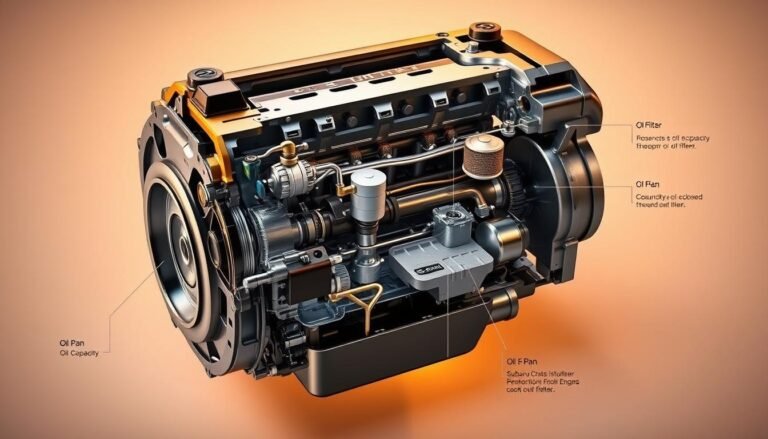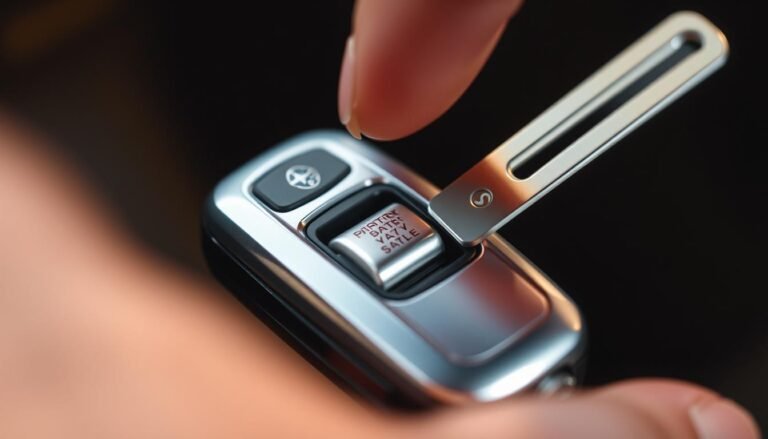Subaru Head Gasket Issues: Causes & Solutions
Many car owners know about Subaru head gasket issues especially with EJ25D engines from 1996 to 1999. These problems often come from the engine getting too hot.
This can cause leaks inside the engine that may harm it badly. In this article, we’ll look at these problems closely. We’ll see how they can affect your car and what you can do about them.
Knowing about these issues is very important. It helps you make good choices about fixing or replacing the head gasket in your Subaru.
Subaru head gaskets usually fail between 120,000 and 150,000 miles. It’s really important to notice the early signs. These can be weird readings on your coolant temperature or your car overheating.
We’ll show you how to handle these problems. This way, you can fix them without spending too much money.
You’ll learn maintenance tips and when you should get a professional to look at your car. This guide will give you the tools to deal with head gasket issues confidently.
Next, we’ll dive into how head gaskets work and why they’re so important. You’ll understand why keeping them in good shape is key to your Subaru’s long life. Let’s get started!
What is the Role of the Head Gasket?
The head gasket plays a huge role in your Subaru’s engine. It sits between the engine block and the cylinder head. Its main job is to keep engine oil and coolant from mixing.
This is vital for keeping pressure right during combustion, making sure your Subaru runs smoothly. A working head gasket also helps the engine stay cool.
This keeps your engine safe from getting too hot. If the head gasket fails, it can cause big problems. Your engine could get so damaged it might need to be completely rebuilt or replaced.
This could cost a lot of money. Regular checks can catch problems early, saving you money and hassle.
Knowing about your Subaru’s head gasket is key for taking good care of your car. By looking after it, you can make this part last longer. This means your car will be more reliable over time.
Common Subaru Head Gasket Issues
Subaru head gasket failure mostly comes from two types of leaks: internal and external. The Legacy and Impreza models from 1996 to 1999 often have internal leaks.
This leads to big issues like engine overheating because of coolant loss. When you see oil in the coolant overflow or high coolant temperatures, these could be signs of serious internal leaks.
Starting in 2000, models like the Forester and Outback began showing more external leaks. These don’t usually cause overheating.
Instead, they result in coolant mixing with oil, endangering the engine’s health. Subaru used composite head gaskets from 1999 to 2009, which were more likely to fail.
However, they shifted to multi-layer steel (MLS) gaskets between 2010 and 2012. This change was good for fixing external leaks, but internal failures could still happen, typically between 120,000 and 150,000 miles.
Knowing about the different types of head gasket leaks is crucial. It can help Subaru owners, both current and future, protect their cars from these issues.
The following table provides important details on common Subaru head gasket problems:
| Model Years | Head Gasket Type | Leak Type | Common Symptoms | Average Mileage at Failure |
|---|---|---|---|---|
| 1996-1999 | Composite | Internal | Overheating, oily coolant | ~150,000 miles |
| 2000-2009 | Composite | External | Coolant mixing with oil | ~150,000 miles |
| 2010-2012 | MLS | External/Internal | Coolant loss, overheating | ~120,000 to 150,000 miles |

Subaru Head Gasket Issues: Causes & Solutions
The causes of Subaru head gasket problems are linked to the materials and design choices. Switching from multi-layer to single-layer steel gaskets with a graphite coat led to more failures.
Vehicles like the Outback, Forester, and Impreza start having issues after hitting around 100,000 miles. These include leaks of coolant and oil.
Knowing these Subaru engine design flaws helps in tackling issues early. Quickly dealing with head gasket issues can avoid big repair bills.
For head gasket repair solutions, using stronger multi-layer steel gaskets is a smart move. These are better at standing up to stress and don’t fail as easily.
Keeping up with regular maintenance and checks helps catch issues before they worsen. This can keep you from spending over $2,000 on repairs.
Subaru cars made between the late 1990s and early 2000s are more likely to have these issues. About 10% of Subarus fall victim to head gasket problems.
The 2.5-liter EJ25 SOHC engine models are known for leaking oil, so they need careful watching. Signs like overheating, bubbles in radiator coolant, and coolant in the engine oil are red flags not to be ignored.
Luckily, Subaru offers special programs and extended warranties for some models to help owners with repair costs.
By using these aids and following maintenance advice, you can lessen the risk of head gasket failures.
Identifying Subaru Head Gasket Symptoms
Spotting Subaru head gasket symptoms early can prevent major engine damage and save on repair costs. This problem is common in Subaru cars, particularly in models like the Forester, Impreza, and Outback.
It usually happens after 80,000 to 100,000 miles. A key sign of failure is an overheating engine, which could mean coolant is leaking. This puts more stress on the engine.
Keep an eye out for these key signs of head gasket failure:
- White exhaust smoke from the tailpipe
- Water leaking from the tailpipe
- Milky white oil in the reservoir
- Exhaust bubbles in the coolant reservoir
- Pungent smell from the coolant reservoir
- Low coolant levels, often occurring with or without visible external leaks
- Rough idling and engine knocking
Continual overheating engine indicators signal serious problems. If you see blue exhaust smoke, it could mean different issues, including head gasket failure.
Bubbles in the radiator from exhaust gases also point to a blown head gasket. Ignoring these symptoms can worsen engine damage.
Regular check-ups, like oil changes and coolant flushes, can lower the risk of head gasket problems. Not heeding these warnings can lead to severe damage, such as cracks in the engine block. These repairs are much more expensive.

Subaru Head Gasket Replacement: What To Expect?
Replacing head gaskets in Subaru vehicles requires keen attention. The process involves taking out major engine parts, like the cylinder block. This is to get to the broken gaskets. Get ready for this work to take a good few hours.

It’s key to pick top-quality materials for the new gaskets, such as multi-layer steel ones. These are more durable and lower the chance of the same problem happening again.
Remember, the amount of labor impacts the price. It’s smart to talk with a mechanic you trust on what to anticipate. After putting in the new head gaskets, watch the coolant and oil levels closely.
This is important in the first few weeks. Seeing changes might mean there are new problems. Following these steps can help keep your Subaru running well and prevent future gasket issues.
Cost Considerations For Head Gasket Repair
Understanding the costs for a Subaru head gasket is important. The repair cost usually falls between $1,200 and $2,500.
This includes both parts and labor. For a Subaru Outback, the cost can be about $2,000, depending on different factors.

Luxury Subaru models or newer ones can cost more to repair. This is due to special parts and complex repair methods. For older models, the unique engine design can make repairs more complex.
This leads to higher labor time and costs. Subaru Forester owners often pay between $1,800 and $3,000 for a replacement. The cost of labor for this repair can vary a lot.
It depends on where you live, which mechanic you choose, and your Subaru’s model year. On average, it’s between $1,500 and $3,000. Some Subaru Impreza owners have spent about $1,979, plus tax, for a car with 114,000 miles.
Trying to replace a head gasket by yourself is not recommended. The process is complex and requires specific tools and skills. Be prepared for added costs for other maintenance items.
These, like timing belts and thermostats, can increase the total expense to $4,000. Regular maintenance is key to avoiding major repairs. It helps spot problems early.
This can save you from expensive repairs later. Taking care of issues promptly makes owning a Subaru more affordable in the long run.
Preventing Head Gasket Failure in Your Subaru
To keep your Subaru’s head gasket healthy, stay on top of maintenance. Changing your oil and coolant regularly helps avoid engine damage. Use engine oil that’s right for Subaru cars.
This oil keeps the head gasket working longer. Make sure to flush the coolant every 3,000 to 5,000 miles to reduce head gasket failure risks.
Watching your engine’s temperature is also key. Keep it below 240°F to prevent overheating, which often leads to gasket issues. Be on the lookout for milky oil, a sign of coolant problems.
Catching these signs early can save you a lot of money on repairs. Follow Subaru’s care advice and keep up with scheduled check-ups.
Regular checks help spot problems early, keeping your car running smoothly. Always choose original or top-quality parts for replacements to ensure your car’s reliability and prevent issues.
Subaru Head Gasket Warranty and Recall Information
Subaru has taken steps to address head gasket issues with a special warranty. This warranty is for some models, especially those made from the mid-1990s to early 2000s.
It helps with repair costs for up to 8 years or 100,000 miles. But, it mainly covers problems related to coolant, not oil leaks.
A few Subaru models have been recalled due to head gasket problems. Despite improvements, some owners still worry about their car’s reliability.
The 2.5L four-cylinder engines are most often affected. These issues can lead to expensive repairs, costing around $2,200 on average.
It’s important to stay up-to-date with Subaru’s extended warranty info. Checking service bulletins regularly can inform you about available support.
Through the warranty, Subaru has helped some owners pay for repairs. This support makes fixing head gasket issues easier and less costly.
Knowing your warranty status helps you get assistance early on. Being proactive with maintenance checks can also prolong your Subaru’s life. This way, you can avoid bigger issues down the road.
Conclusion
It’s really important for car owners, especially if you have a Subaru Outback, Forester, or Impreza, to know about head gasket problems.
Compromise these issues means you can keep your car running well. Catching problems early can save you money, showing how important regular checks and good parts are.
If you ignore small problems, they can turn into bigger, costly ones. Doing things like keeping an eye on your coolant and changing your oil on time can help your head gasket last longer.
Knowing about Subaru’s warranty and help programs can make fixing your car less of a strain on your wallet. These actions not only make your Subaru more reliable but also make owning it better for you in the long haul.
Putting your car’s maintenance first and knowing about Subaru’s issues can make owning one a good experience.
Being ahead of the game helps you enjoy your Subaru for many years, without the worry of head gasket issues slowing you down.
FAQs
What are the common symptoms of Subaru head gasket problems?
Common symptoms include overheating and white smoke coming out of the exhaust. You may also find milky engine oil, which indicates coolant contamination. Other signs are reduced engine power and visible leaks of coolant or oil around the engine.
How much does Subaru head gasket replacement typically cost?
The cost to replace a head gasket usually falls between
FAQ
What are the common symptoms of Subaru head gasket problems?
Common symptoms include overheating and white smoke coming out of the exhaust. You may also find milky engine oil, which indicates coolant contamination. Other signs are reduced engine power and visible leaks of coolant or oil around the engine.
How much does Subaru head gasket replacement typically cost?
The cost to replace a head gasket usually falls between $1,000 and $1,500. Labor costs could push the total to as much as $2,000. This depends on the Subaru model and the type of engine.
What can cause head gasket failure in a Subaru?
Head gasket failure often comes from the type of materials used, such as single-layer gaskets. These can fail after about 100,000 miles due to wear and overheating.
Is there a warranty or recall for Subaru head gasket issues?
Subaru has extended warranties for some models with head gasket problems, but not all models have recalls. It’s smart to check your car’s warranty status and look for any service bulletins.
Can I repair a blown head gasket myself?
DIY repair is possible, but you need good mechanical skills and the right tools. For a good fix, it’s essential to use high-quality parts, like multi-layer steel gaskets.
What regular maintenance can help prevent head gasket problems?
Change your oil and coolant regularly, and keep an eye out for leaks. Address any overheating quickly. Using OEM parts for repairs also helps keep head gasket issues at bay.
Which Subaru models are most likely to experience head gasket issues?
Subaru models made from 1996 to 1999, like the Legacy and Impreza, often have internal leaks. Models from 2000 onwards, such as the Forester and Outback, are more prone to external leaks.
,000 and
FAQ
What are the common symptoms of Subaru head gasket problems?
Common symptoms include overheating and white smoke coming out of the exhaust. You may also find milky engine oil, which indicates coolant contamination. Other signs are reduced engine power and visible leaks of coolant or oil around the engine.
How much does Subaru head gasket replacement typically cost?
The cost to replace a head gasket usually falls between $1,000 and $1,500. Labor costs could push the total to as much as $2,000. This depends on the Subaru model and the type of engine.
What can cause head gasket failure in a Subaru?
Head gasket failure often comes from the type of materials used, such as single-layer gaskets. These can fail after about 100,000 miles due to wear and overheating.
Is there a warranty or recall for Subaru head gasket issues?
Subaru has extended warranties for some models with head gasket problems, but not all models have recalls. It’s smart to check your car’s warranty status and look for any service bulletins.
Can I repair a blown head gasket myself?
DIY repair is possible, but you need good mechanical skills and the right tools. For a good fix, it’s essential to use high-quality parts, like multi-layer steel gaskets.
What regular maintenance can help prevent head gasket problems?
Change your oil and coolant regularly, and keep an eye out for leaks. Address any overheating quickly. Using OEM parts for repairs also helps keep head gasket issues at bay.
Which Subaru models are most likely to experience head gasket issues?
Subaru models made from 1996 to 1999, like the Legacy and Impreza, often have internal leaks. Models from 2000 onwards, such as the Forester and Outback, are more prone to external leaks.
,500. Labor costs could push the total to as much as ,000. This depends on the Subaru model and the type of engine.
What can cause head gasket failure in a Subaru?
Head gasket failure often comes from the type of materials used, such as single-layer gaskets. These can fail after about 100,000 miles due to wear and overheating.
Is there a warranty or recall for Subaru head gasket issues?
Subaru has extended warranties for some models with head gasket problems, but not all models have recalls. It’s smart to check your car’s warranty status and look for any service bulletins.
Can I repair a blown head gasket myself?
DIY repair is possible, but you need good mechanical skills and the right tools. For a good fix, it’s essential to use high-quality parts, like multi-layer steel gaskets.
What regular maintenance can help prevent head gasket problems?
Change your oil and coolant regularly, and keep an eye out for leaks. Address any overheating quickly. Using OEM parts for repairs also helps keep head gasket issues at bay.
Which Subaru models are most likely to experience head gasket issues?
Subaru models made from 1996 to 1999, like the Legacy and Impreza, often have internal leaks. Models from 2000 onwards, such as the Forester and Outback, are more prone to external leaks.







